The blocky, flat-shaded 3D fighters first seen in 1993's Virtua Fighter have sure come a long way. Nearly 10 years after the original arcade game was released, Sega's Virtua Fighter series now spans four games, not to mention a number of weird spin-offs like Virtua Fighter Kids and the outrageous Fighters Megamix. Virtua Fighter games have appeared on virtually every Sega system ever made. Last year, Sega bowed out of the hardware business, so the latest installment of Virtua Fighter is the first that isn't exclusive to Sega's own hardware. And PlayStation 2 owners couldn't be luckier, because Virtua Fighter 4 is the best fighting game to debut since Namco's superlative Dreamcast version of Soul Calibur back in 1999. Virtua Fighter 4 is also the best game in the series to date: It offers even more of the depth that fans of the series have enjoyed for years, yet it also quickens the pacing, streamlines the controls, and fixes the problems found in previous installments. Furthermore, the PS2 version of Virtua Fighter 4 packs some interesting bonus features and the best artificial intelligence hands down of any fighting game. Superficially, Virtua Fighter 4 may resemble any number of other graphically impressive 3D fighters. But the real beauty of it is definitely in the gameplay.
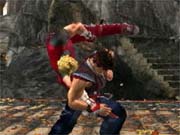
Virtua Fighter 4 has 13 characters you can choose from, two of which are new to the series. Only Virtua Fighter 3's conspicuous sumo wrestler Taka-Arashi didn't make the cut--all the other fighters from the series are back with new moves and new looks, including such favorites as the Japanese martial arts expert Akira, the massive Canadian pro wrestler Wolf, and the blonde-haired high-kicking siblings Jacky and Sarah Bryant. As in all previous Virtua Fighter games, the last bout in Virtua Fighter 4's arcade mode is against Dural, basically a very mean female mannequin made of metal (there's a way to unlock her as a playable character for use in the versus mode). The first of the game's new fighters is Lei Fei, a shaolin monk whose dizzying kung fu skills are as effective as they are spectacular. The second is Vanessa Lewis, who looks like X-Men's Storm and specializes in both defensive counterthrows and in kickboxing. Lei Fei looks better in action than Vanessa, though both of the new characters have dozens of interesting moves. Actually, the same can be said for all the characters, not just the new ones. Each returning fighter boasts a number of new abilities, many of which become important additions to their repertoires. Many of the new moves aren't just punches or kicks--they're complex techniques like deflections, reversals, and alternate fighting stances.
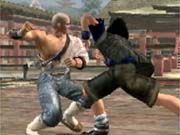
Virtua Fighter 4 isn't just for hard-core fighting-game fans--the game is only as complex as you want it to be. While it will definitely appeal to you if you enjoy poring over long-winded character FAQs or spending an evening just practicing the same tough move or combo over and over, you'll also enjoy it if you just want to play for fun. The majority of the game's playable characters are very easy to pick up--by the manual's own admission, more than half of them are well suited for beginners, even for those who've never played a fighting game before. All of the fighters are competitive, yet all of them are substantially different. There's much more differentiation now between some of the characters who seemed similar to each other in previous installments.
What all the characters do have in common is that they respond equally well to the game's flat-out perfect controls. Virtua Fighter 4 reverts back to the deceptively simple control scheme found in the first two games in the series: There's a punch button, a kick button, and a guard button. The evade button introduced in Virtua Fighter 3 is gone, yet lateral movement and evading attacks are still easily accomplished just by tapping up or down on the directional pad, to shift your character away from or toward the screen. You don't necessarily need to know that--using some of the characters, you can have a good time just mashing on buttons, watching as they perform various great-looking strings of attacks. But sooner or later you'll notice that Virtua Fighter 4 rewards skill and precision. The pacing of a typical match is just right--very fast and intense, but not frantic. Most of the moves in the game are easy to execute, but there's still a lot to remember if you want to get good. And some of the more advanced techniques and combos are as challenging, and rewarding, as fighting game moves get.
The gameplay in Virtua Fighter 4 will be familiar to those who've played other games in the series. Characters can no longer jump 10 feet in the air (they hardly jump at all anymore), but they can now use a quick recovery move to instantly get back on their feet as they're knocked down. Recovery times on a lot of moves have been trimmed down by fractions of a second, a subtle change that makes Virtua Fighter 4 seem faster paced than the previous games, because it is. The battles themselves are fought with wits as well as fists and feet. You need keen reflexes and an active mind to mix up high, middle, and low strikes to keep your opponent guessing, and you can move in 3D to set up attacks from the sides and sometimes even from behind. Throws are essential against overly defensive types, while some characters have reversals that can be the undoing of an overzealous attacker. In general, each character has dozens of moves, and most all of them can be useful. You may find yourself relying on certain moves a lot, but you aren't limited to them.
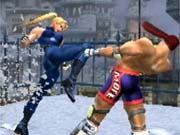
One of the best things about the game is that even if you're not a veteran fighting-game player going into it, it gives you all the tools you need to become one. For starters, Virtua Fighter 4 has no fewer than three different types of training modes: One lets you practice every last move for any of the characters. At the touch of a button, you can watch a demonstration of what the move looks like, and then you can try it for yourself against Jacky, who's a suitable stand-in for a training dummy. There's also a training mode that walks you through all the game's elements--from basics like blocking, to intermediate skills like evading, on up to learning how to deal the greatest amount of damage in the shortest possible time. You can go through this comprehensive step-by-step tutorial piecemeal, and these concise lessons will explain Virtua Fighter 4's complex underlying mechanics and reveal much of its incredible depth. In addition to this tutorial, there's also a free-sparring mode that lets you customize the computer opponent's behavior and basically lets you try out whatever you've learned. Virtua Fighter 4 is easy to pick up and play, but there's so much to it that you'll probably find yourself spending hours in its training modes, focusing on trying to learn just one or two characters at a time.

Regardless of your skill level, the game's AI does an incredible job of scaling to your abilities and providing a great challenge. Most fighting games neglect putting in a good AI, a design compromise that's perhaps understandable. After all, it's a given that fighting games are at their best when they're being played competitively with other people. But just as fighting games aren't as popular in arcades as they used to be, so is it the case that most players won't always have a willing human opponent on hand whenever they want to play at home. Fortunately, with Virtua Fighter 4, even when you don't have someone else around to play against, you'll find that the computer opponent provides an excellent alternative.
The computer opponent noticeably catches on to some of your tricks. At higher levels, you'll see it pulling off the toughest moves at the best opportunities. Yet even at higher levels, the computer still fights fair--it doesn't flaunt superhuman reaction times, and it doesn't block or reverse absolutely everything you throw at it. You need skill rather than patterns or dirty tricks to beat it. All this is not to suggest that the AI in Virtua Fighter 4 is as good as a skilled human opponent--after you've played against the AI several hundred times, you'll probably pick up on how a few types of techniques do seem to work better than others. But the fact that the AI always puts up a serious fight is a distinguishing feature that's unique to Virtua Fighter 4 among all fighting games.
Virtua Fighter 4 sports an arcade mode where you'll square off against every character, including your own, before facing Dural. Your opponents become progressively more difficult, but before you get started, you can tweak the game's settings in the options screen, adjusting the overall difficulty and defining a number of other gameplay parameters. But the best way to play against the computer isn't in the arcade mode, but instead in what's called the kumite (which can be translated from Japanese as "tournament") mode. It's like a survival mode--you'll face a continuous sequence of opponents in best-out-of-five-round bouts. The great part is that the game can track your win/loss record, as well as a truly staggering array of statistics about your fights (things like "low throw escape rate" and "percent of damage taken from reversals"). There's even an advice screen you can refer to that uses these stats to give you practical suggestions on how to improve your skills.
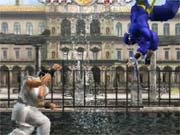
As you win kumite matches, you'll gain higher ranks and find yourself facing more-challenging opponents. Sometimes you'll unlock custom goodies for your character including hats, necklaces, tattoos, sunglasses, and more. You can equip these and also change the color of your character's outfit to give him or her a distinct appearance. You even get to name your fighter, and you'll find that computer opponents will often have very funny names of their own. The kumite mode does a great job of rewarding you simply for playing a lot. But you'll also feel compelled to keep ranking up--especially since, if you start doing poorly, you can be demoted. Ultimately, the kumite mode manages to bring forth a lot of the excitement of playing fighting games competitively at the arcades. The home version of Virtua Fighter 4 captures the thrill of not knowing exactly how good the next opponent will be, along with the sense that there's something at stake in every battle. Naturally, the character you've built up in kumite mode can be pitted against human opponents as well. After all, the best part about customizing your character is being able to show him or her off to your friends.
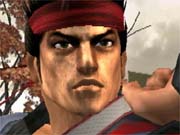
Every game in the Virtua Fighter series has looked terrific, and Virtua Fighter 4 keeps the trend going. The PS2 version looks nearly as good as the arcade version. The fighters appear much more lifelike than in previous installments--and tougher too. The characters' individual physiques and even their complexions are well defined, and the detail in their facial expressions is impressive. Their new moves look great, though if you've played previous Virtua Fighter games, you'll notice that the animations for old moves have been recycled (though the old moves look great too).
The backdrops for the bouts in Virtua Fighter 4 generally aren't quite as interesting to look at as the various locales from the previous game, though they're better to fight in. Virtua Fighter 3's rolling scenery sure looked pretty, but it caused some problems with collision detection and generally just didn't feel right. In Virtua Fighter 4, as in the first two games, every battle takes place in a flat square arena--in this case, the arenas are amid detailed scenery, including a beach resort, a traditional Japanese dojo, a subterranean river, and that classic fighting-game setting, the Great Wall of China. Some arenas are open, allowing you to knock your opponent out of the ring for a quick but well-deserved victory. Others are closed off--if you force your opponent to the edge, you'll have the perfect setup to inflict major damage. Still others are closed off but can be broken through if you pound your opponent hard enough against a wall. Ring-out victories are a lot more satisfying when there's a broken wall involved.
The stages in Virtua Fighter 4 may all be square, but there's a good amount of visual variety to them, and some of them sport some really great effects--one is covered in about a foot of snow, which deforms realistically as the characters move through it. Another stage takes place in ankle-deep water that splashes and undulates like the real thing. Yet another has a surface made of ceramic tiles that shatter whenever your opponent falls on them. Virtua Fighter 4 does suffer from some aliasing problems that can be very apparent in the jagged-looking background scenery, though depending on your television set, you might not really notice. Virtua Fighter 4 may not be the most visually stunning game--its appearance is more realistic than over the top--but it's still easily one of the best-looking 3D fighting games ever made.
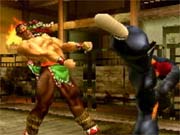
The least remarkable quality of Virtua Fighter 4 is its audio. The game still uses many of the same exact sound effects from the original Virtua Fighter, and a lot of the character voices are recycled too. On its own terms, the game sounds fine, but not particularly special--at least some of the English dialogue doesn't sound as awkward as it did in the previous games. The soundtrack, light on percussion and heavy on synthetic instruments and electric guitar licks, is upbeat and similar to the scores of the previous games in the series, but it is generally forgettable.
The humdrum sound is indicative of how, despite all the great features, Virtua Fighter 4 does have somewhat of a no-frills sensibility. For better or worse, though, that's always been the case with the series. What little story there is in the printed manual is nowhere to be found in the game itself--don't expect to be treated to an ending sequence when you beat the arcade mode. The game's menu system is awkward. You need to go out of your way to create a data file for each character and then load it up before you begin a match. In the versus mode, there isn't a quick way to change the background stage you're fighting on. The game's loading times, while certainly not slow, are noticeable. You can imagine a world where these sorts of things could have been better, but in the end they have nothing to do with the core gameplay of Virtua Fighter 4, which is fantastic.
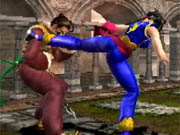
The game does have one really interesting extra feature: an AI training mode, where you must teach a computer-controlled fighter all its moves and when to use them, first by demonstrating the moves yourself and then by providing positive or negative reinforcement when the computer experiments with them. Another way to train the AI is to show it replays of some of your battles--you can optionally save a replay at the end of any match. Once you've taught your trainee fighter a thing or two, you can then put it through the kumite mode, pit it against your friends, or even pit it against their own AI-controlled fighters. It's certainly a novel idea, though it's poorly explained in the manual and certainly not as much fun as actually playing the game yourself.
You can't tell right off the bat, but Virtua Fighter 4 is the best fighting game in years. Even if you've never liked the Virtua Fighter series before--and there's a reasonable chance that's the case, considering the series has never taken off in the US like it has in Japan--you should still give Virtua Fighter 4 a try. The quicker pacing, the perfected controls, and the great-looking character designs, along with the outstanding AI and the unparalleled gameplay depth, make this a fighting game that just about everyone will agree on.